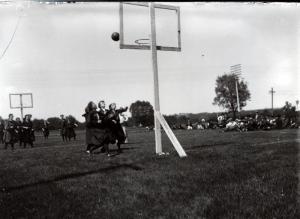
Long before Jack Trice Stadium, Cap Trimm Field, Forker Tennis Courts, and the Cyclones Sports Complex, Iowa State hosted its inter-collegiate sports on what were known as the “Athletic Fields.” These fields were home to the baseball team, football team, track and field team, and tennis team.
Organized athletics on the Iowa Agricultural College campus started in Fall of 1882 with the creation of the Gymnasium Association in the hopes of establishing a regular exercise program for students. In May of 1884, a Base Ball Association was established to coordinate games between classes, town clubs, and rival colleges, and was championed to the young men of the campus for its “lusty and vigorous exercise.” By 1888 sports were becoming more of an interest at the college, and there was a call in the student newspaper Aurora for the development of an outdoor sports program with the thought that inter-collegiate games would foster even more interest. In the fall of 1889 a “field day” was arranged by Professor of Military Science Captain J. R. Lincoln and Professor of History and English Literature A. C. Burrows devoted to all matter of athletic sports.
The following April, the College joined fifteen other Iowa colleges to form the Iowa Inter-Collegiate Athletic Association with the purpose of an annual state field day. The increased interest in sports meant that a need for athletic grounds at the college was becoming evident. Land was set aside for “Athletic Grounds” to the west of the Main Building that would feature a circular track for distance events bisected by a straight line track for sprint and hurdle events. These grounds would be short lived as events in 1892 would lead to the call for more space.

In March 1892 the College joined the State University (University of Iowa), Grinnell College, and Drake University to form the Iowa Intercollegiate Baseball Association, marking the beginning of varsity baseball at Iowa Agricultural College. The following fall saw the creation of the first varsity football team at IAC. Additional space was needed for these new varsity sports, and expansion of the Athletic Grounds was hampered by its location in proximity to a railroad spur. During the September 1892 Board of Trustees meeting the Board approved the assigning of “…a strip of ground north of the railroad as far as the orchard fence” to the Athletic Association for Athletic Grounds. This eight acres of land was north of the previous Athletic Grounds and to the west and northwest of Morrill Hall. The Board would also appropriate $200 in December 1892 to aid in the fitting up of the grounds, and in May 1893 authorized President Beardshear to use portions of the Public Ground Fund for improving the Athletic Grounds and to use the Farm and Horticulture teams for the same purpose when not interfering with the work of the departments. A house and barn was located on this tract of land and the College spent $643.30 to purchase, repair, and move both structures. Due to financial constraints, work on the track was delayed, and it wouldn’t be until May 1894 that it would be completed. That same spring the College joined eight other Iowa colleges in the formation of the Iowa Inter-Collegiate Tennis Association, formalizing tennis as a varsity sport after it had grown in popularity on campus.
This new Athletic Grounds would feature a baseball diamond, football field, 1/3 mile track, and 4 dirt tennis courts. The baseball diamond was located in the northwest corner of the grounds, the tennis courts at the southwest corner, the football field occupied the eastern portion, and the whole area was ringed by the track. Field sports like pole vault, shot put, and hammer throw were located on the southeastern portion of the grounds.
Additional improvements were not made to the grounds until 1900. At this time the grounds were fenced in and bleachers were added. This allowed the the Athletic Association to begin producing revenue at sporting events. The grounds would eventually become to be known as State Field.




Within a few years relocating the field was already being discussed as recorded in the Biennial Report of the College for 1903-1905:
“The development of the College has been such as to necessitate the early removal of the athletic grounds from their present location near Engineering Hall to the Southwest corner of the campus. Quite extensive grading will be necessary to put the grounds in shape.”
The athletic fields wouldn’t be moved until 1914, a year after the completion of State Gymnasium. Baseball, football and track would have a new home just south of State Gymnasium at “New State Field,” and eventually talking the name “State Field.” The football field would be named in honor of its from head coach (1906-1919) and athletic director, Clyde Williams, in 1938. Tennis courts would be created just across West Street (now Union Drive) to the north of State Gymnasium.
Information for this post was gleaned from a number of sources including: maps from Facilities, Planning and Management records [RS 4/8/0/7], Iowa Board of Regents Minutes [RS 1/8], University Photograph Collection, Aurora [LD2541.8 A97x], Biennial Report of the Iowa State College of Agriculture and Mechanical Arts [LD2531 Io9r], and The Iowa State University Campus and its Building [LD2543 I6 D39x].





